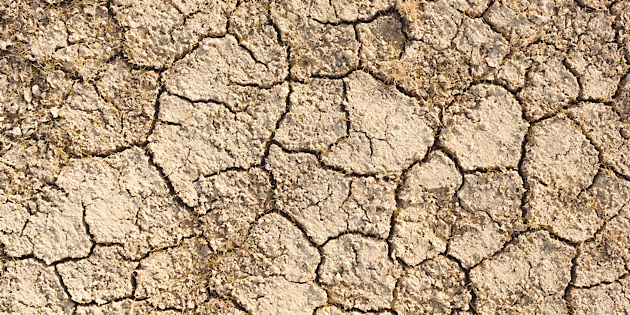Image courtesy of Wesley Tingey/Unsplash.
This article was orginally published by New Security Beat on 3 March 2020.
Climate change is widely recognized as a “threat multiplier.” From the United Nations to the G7 to the US Department of Defense, there is emerging consensus that climate change poses risks to both human and natural security through a variety of complex and interrelated channels. The extent of those risks, and how they connect to armed conflict, however, remain widely debated.
In a recent study published in Nature, a team of leading conflict experts concluded climate variability and/or change was only a modest contributor to armed conflict since WWII, with factors like low socioeconomic development, low state capacity, and intergroup inequality emerging as vastly more consequential.
I was one of those experts. And while I stand by the results of the study, I worry we may be massively underestimating the impacts of climate on armed conflict. We’re doing so because our standard approaches to analyzing climate-conflict links—which focus on changes within political units over time—are uniquely unhelpful for thinking about variation across political units. That is, we have focused more attention on comparing Kenya in times of drought to Kenya in times of heavy rains than asking whether the vast differences in socioeconomic development and state capacity across the world are in part attributable to climatic conditions.
The aforementioned Nature piece notwithstanding, there is still considerable disagreement over the magnitude of effect, direction of effect, scale at which effects are most present, and contextual mediators that may amplify or diminish the effects of climate on conflict. However, there is generally more consensus about how researchers seek to identify the effect of climate on conflict: by looking at “shocks”—deviations from normal climatic conditions (heat waves, droughts, flooding, etc.)—and assessing their effects for conflict at different spatial and temporal scales. This approach has considerable merit, and is premised in a very plausible assumption: people responding to extreme situations with extreme behaviors.
However, focusing on these “shocks”—and ignoring the potential impact of broad variation in baseline climatic conditions across countries—may be causing us to significantly underestimate the total influence of climate on conflict.
Low socioeconomic development and low state capacity are two factors most associated by climate-conflict scholars with armed conflict, surpassing by a large margin factors like climate change and physical geography. But what if socioeconomic development and state capacity are themselves products—at least in part—of climatic conditions?
There is a large and relatively influential literature, mostly in economics, linking climate—or factors closely related to climate, such as disease environment, suitability for certain types of crops, and patterns of European colonization and settlement—to economic development and state capacity. In contrast to work on climate-conflict links, these studies tend to look at variation in the cross-section.
Despite disagreement over mechanisms, this literature reaches relatively consistent conclusions: countries with less temperate climates are systematically poorer and governed by less capable states than those countries with more temperate climates. To the extent we believe these findings, we are likely missing large indirect effects of climate operating through low socioeconomic development and state capacity.
These insights have not exerted much effect on how scholars think about climate-conflict links in the present. And I think there are three main reasons why this is the case. First, variation in baseline climatic conditions across countries are just that: variation in the cross-section. Cross-sectional analyses are less convincing to many audiences than panel (i.e., within units over time) analyses in supporting causal arguments.
Second, this literature is largely historical in nature. Other than those arguing for direct effects of current climatic conditions on agricultural productivity and disease environment, like Jeffrey Sachs, the literature on economic development and institutions focuses on processes—like colonization—that occurred in the 16th-19th centuries; the small literature on biogeography places the action even earlier, at climatically-determined plant and animal resource endowments at the dawn of the First Agriculture Revolution over 12,000 years ago. A lot has happened since then. And it’s not clear that cross-sectional differences in climatic conditions and long-run outcomes are useful for helping us think about how, for example, increasing aridity will affect state institutions that were created in the 18th and 19th centuries. Guideposts for policymakers these studies are not.
Third, moving from a discussion of within-unit variability to cross-unit variability raises concern about geographic determinism. Arguments driven by climate and geography are quite vulnerable to attacks on both their left and right flanks. Critical theorists levy the charge that geographical arguments in the main tend to reify existing asymmetries of power, developing ex-post justifications and rationalizations for the dominance of Europe during the colonial and post-colonial periods. Classical and neoclassical theorists, as well as new institutionalists, on the other hand, contend that human ingenuity and—more importantly—institutions trump the direct influence of biological and geographic realities on political, economic and social outcomes.
Whatever the reason for their absence from discussions of climate impacts on armed conflict, it’s my hope these insights will begin to permeate these discussions. The past several decades have made clear how humans are both architects of and hostages to changes in our global environment that will have profound effects for our communities and political systems. However, this perspective discounts how profoundly societies—and the institutions and rules they devise to govern themselves—have been shaped by the environment in the past. In order to get anything close to an accurate accounting of the impacts of climate on armed conflict, we’ll have to grapple with this reality—and begin to think about what it means for policy responses from the development and security communities moving forward.
About the Author
Cullen Hendrix is Professor and Director of the Sié Chéou-Kang Center for International Security and Diplomacy at the Josef Korbel School of International Studies, University of Denver, and Nonresident Senior Fellow at the Peterson Institute for International Economics in Washington, DC.
For more information on issues and events that shape our world, please visit the CSS website.


